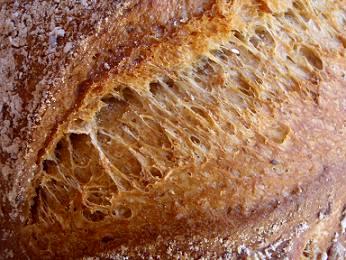My son asked if I could make hot cross buns for Easter three months ago, so I Googled the recipe and a whole new world opened up to me. Up until then, I had hardly used internet recipes, and guess what - the first hot cross bun recipe that I came across was Dan Lepard's recipe and it came with this excerpt from Dan's website:
"Good bread comes from an understanding of its nature... a good baker recognizes that the doughs he makes are living things with individual identities, that they ultimately create themselves. The baker's skill is to encourage natural developments ...."
These few words enlightened me and I have since moved away from pastries and have come to a completely new frontier - sourdough! I began researching sourdough day and night for a period of three months non-stop. Before Easter, I had never heard of the word "sourdough." I had made pastries for years and yeasted breads using bread machine every now and then, but strangely I had never heard of "sourdough" up until that point.
I was trying to explain to my sisters back in Taiwan about this curious dough. I had to translate the word into Mandarin to make myself understood. I said it is a "suan-mientuan," meaning "sour-dough" in Mandarin but I was not happy with the translation. Soon after that, I started to use "tian-ren-fa-hsiao-mientuan," meaning "naturally-leavened dough" to describe it and I am much happier with this translation.
I had leftover molasses mixed in water from making the last Horst Bandel's Black Pumpernickel. I love the rich taste and aroma of molasses and I wonder what it would be like to put it in sourdough. Here I go the fanciful side of me is working.
This Molasses & Light Rye Crusty Sourdough is my tribute to Dan Lepard. I thank him for opening up a brave new world of sourdough to me.

Molasses & Light Rye Crusty Sourdough


My formula
196 g molasses starter @ 100% hydration (note: I used one part molasses to 9 parts water and 10 parts flour)
160 g rye starter @ 100% hydration
278 g KAF Sir Lancelot high gluten flour
121 g molasses water (again, one part molasses to 9 parts water)
22 g olive oil
9 g salt
(final dough weight 786 g, dough hydration 70%)
The dough was bulk fermented for 4 hours and during that time it received 3 folds. Shaped, then into the fridge for cold retardation for 10 hours. Proofed at room temp for 2 & 1/2 hours this morning before baking.
I have found something quite useful for new sourdough baker like myself and that is to NOT over-steam the oven. With too much steam, the scores would seal up quickly in the oven and would not give nice grigne.
We had this sourdough for brunch today and it was really lovely. My son said he could smell a pleasant sourness. He had a slice with peanut paste (how typical for a growing boy). My daughter had it with grilled capsicum in an open sandwich; my husband had his with a thick layer of butter, and I had it as is. AND, Polly our dog got a slice too!

As the loaf is being sliced ...

Polly awaits anxiously ... to get her share.
Happy baking!
Shiao-Ping